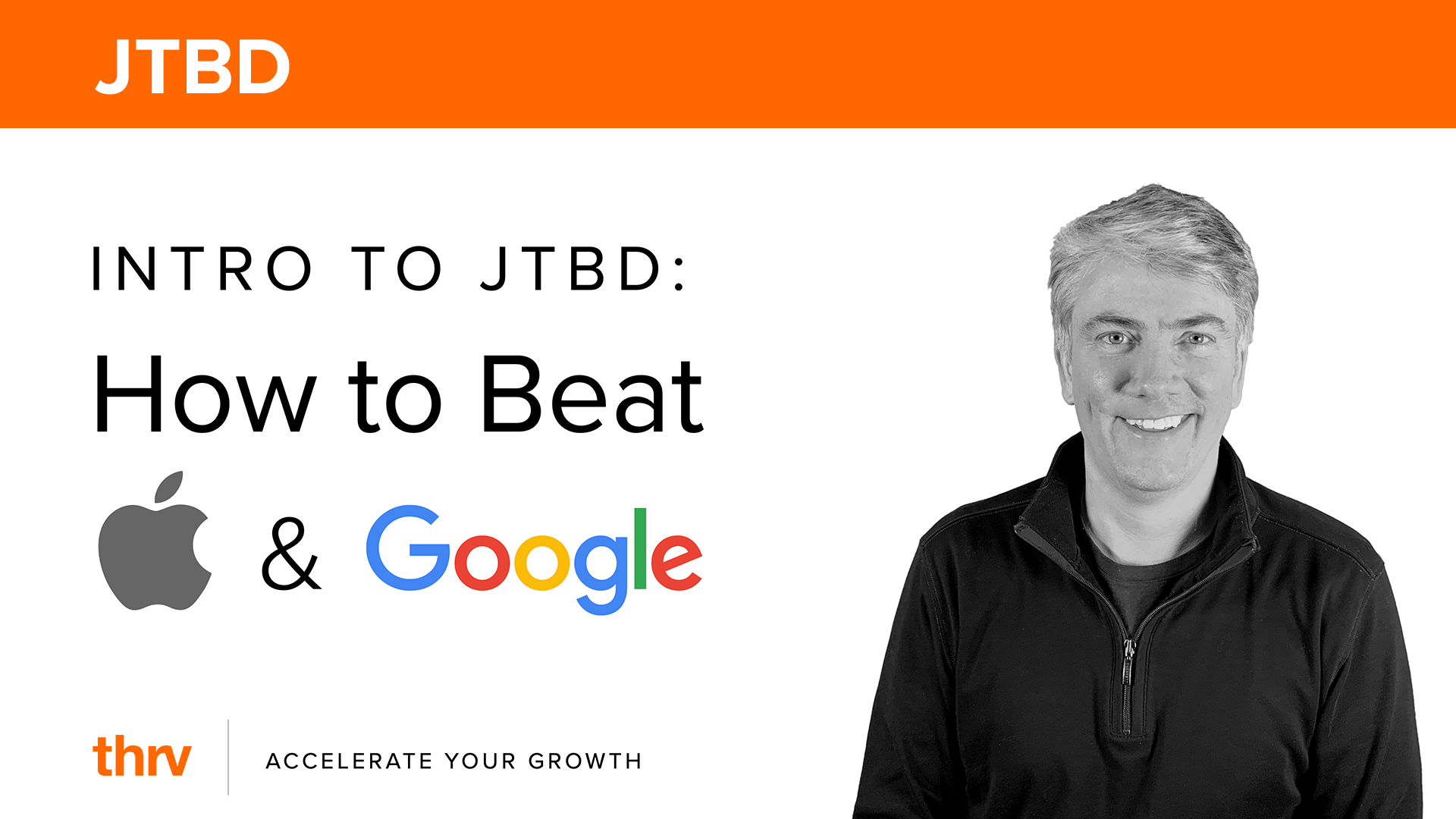February 6, 2018
How to Answer The Question "What's the job-to-be-done?"

Over a year after the publication of Clayton Christensen’s book about Jobs Theory, Competing Against Luck, Jobs-to-be-Done is a much more common topic at companies of all sizes and sectors. As the question, "What's the job-to-be-done?" becomes ever more frequent, confusion around how to answer the question rises. Product managers and executives we work with often wonder if their colleagues know the difference between a good and bad answer.
This post provides pointers to help you detect and articulate a useful jobs-to-be-done statement:
- The right question is, “What’s your customer’s job-to-be-done?”
- The JTBD should be a simple sentence consisting of an action verb and a direct object.
- Confirm the statement does not include a solution
- See if it passes the wake up in the morning test.
A well-articulated jobs to be done list normally sets a point of focus that will lead to developing high-growth products. Let’s dig into the criteria in more detail.
Whose job is it?
One of the biggest mistakes is defining “the job-to-be-done” as your company’s job. Of course, companies should have goals, but to hit them, you need to understand your customer. The “job” in Jobs-to-be-Done is your customer’s job. The foundation of the method is understanding your customer will lead to building solutions they value, leading to growth for your company.
Your product team’s goal is to get your customer’s job done for them.
Instead of asking “What’s the job-to-be-done?” make it standard practice to ask, “What’s our customer’s job-to-be-done?” By asking the right question, your team will get off to a much better start in defining the job-to-be-done.
What is a job and why does this matter?
A job-to-be-done is a goal your customers are trying to achieve independent of any product or solution. According to Jobs Theory, your customers are not buying your products; they are hiring them to get a job done. Their struggle with achieving the goal causes them to purchase new solutions.
In other words, the goal of building new products is to satisfy customer needs better than competitors in your market.
What is a market?
The traditional definition of a market, often used for market sizing, is “product price X number of buyers = the market.”
For example, a team at Microsoft likely used traditional methods to calculate the size of the "iPod" market at its peak. Apple had sold 200 million iPods at $150. Using traditional methods, this logically appears to be a $30 billion market.
Microsoft launched the Zune into the "iPod" market, and it failed dramatically.
The problem was that consumers didn't want iPods any more than they wanted records, cassettes, or CDs. They wanted to get a job done. In this case, they want to create a mood with music--a goal that is independent of any solutions and nearly timeless.
The "iPod" or “MP3 player” market (like the "cassette" market and the "CD" market) is now rapidly approaching $0. New products have emerged (smartphones, streaming apps) that get the job done better for the customer.
The Zune was doomed from the start because Microsoft defined the market incorrectly. They launched a product and used a platform that mirrored the iPod while others focused on the features and platform that would get the job done faster and more accurately.
History is riddled with examples of companies that not only failed but missed enormous opportunities trying to satisfy customer needs better for their products rather than satisfy customer needs better in the job.
Encyclopedia Britannica lost $1 billion in market cap protecting their position in the encyclopedia business. Kodak went bankrupt thinking they were in the film market. Blackberry lost $80 billion in market cap while satisfying needs in the mobile device with keyboard market.
Meanwhile, all three companies missed out on the biggest market opportunities in history.
Google, Facebook, and Apple created three of the largest companies in the world in the same markets that Britannica, Kodak, and Blackberry were competing in. The three markets were: find information, share memories, and get jobs done while mobile. These are all jobs-to-be-done that define stable markets.
If Britannica, Kodak, and Blackberry had defined their markets as jobs-to-be-done, they would have been on the right track to capitalize on these market opportunities.
This is why defining the job correctly is so important. When a team is focused on a stable job, they are released from the constraints and pressure to improve the existing product line. They can now innovate with new technologies and a stable target--satisfying needs in their customer’s job-to-be-done.
What makes a good job statement?
In short, a job is a goal a person wants to achieve in their personal or professional life written with an action verb, a direct object, and including no solutions.
Let’s break this down.
1. Action verb + direct object
Keep it simple, memorable and objective. A customer’s job should be action driven with an attainable goal tied to it - that’s it. Over-complicating a job puts you at risk of multiple interpretations and assumptions.
Examples of JTBDs with an action verb and a direct object:
- Get to a destination on time.
- Restore artery blood flow.
- Sell a used car.
The sentence needs to be easily repeatable. Everyone at the company should be able to state it whenever asked. This creates a common language that is critical to product success. If the language isn’t clear and direct, you may end up with different parts of the company having different perspectives on what the job is. This can cause a systemic breakdown of communication and eventually, of your product development.
Here is an example of a job-to-be-done articulated in a much more complex fashion from Clay Christensen’s Milkshake Marketing:
They faced a long, boring commute and needed something to keep that extra hand busy and to make the commute more interesting. They weren't yet hungry, but knew that they'd be hungry by 10 a.m.; they wanted to consume something now that would stave off hunger until noon. And they faced constraints: They were in a hurry, they were wearing work clothes, and they had (at most) one free hand.
Will everyone at your company remember this entire paragraph?
To align your teams, you can dissect this paragraph as follows.
The job is “eat breakfast.” The customer (the job beneficiary) is commuters.
The job of commuters eating breakfast has customer needs that we can prioritize:
- Avoid getting hungry again before lunch
- Avoid spilling the breakfast on your clothes
- Eat the breakfast within the physical constraints of the commute e.g. with one hand while driving, while standing up on the bus, etc.
Clay also raises the notion of an emotional job at play: “feel entertained while commuting.” This complicates your product team’s situation even further.
Are you working on the eat breakfast job for commuters or the commute to work job?
If you create a solution where the commuter can eat breakfast before beginning the commute, will you have solved the problem?
To stay entertained on the commute, is a podcast a better solution than a milkshake? Does it even matter if the commuter is eating?
This is why we break the job down into a short job-to-be-done statement and a hierarchical job map of customer needs. In practice, when you are trying to align teams in a large organization, these short, unambiguous, measurable, and prioritized statements are much easier to remember and create objective criteria for your new solutions.
2. Establish a goal, not a solution
It’s important the job includes a goal with no implied solutions on how someone might achieve that goal. By keeping the solution out of the job, you stay focused on your customer instead of your product or a technology that is bound to change over time.
There will be a new technology that can get the job done faster or more accurately, and you want to be the one to adopt it in your solution.
Here are examples of jobs-to-be-done statements with implied solutions:
- Play MP3s
- Get more Twitter followers
- Print newspapers
Each of these statements can lead a company to believe that their market is a product or technology, which can cause them to miss revolutionary new technologies that win in the market.
In the first statement above, the solution is MP3s. If your company is focused on an audio file, what will you do when streaming takes over?
“Twitter followers” is the solution in the second statement. Why does anyone want Twitter followers? Perhaps they are trying to acquire new customers or learn from people who share common interests among other solution-independent goals. If your company focuses on helping people gain Twitter followers you are dependent on Twitter and you may miss other ways of helping people achieve their real goals faster and more accurately.
Finally, it may be stating the obvious to point out the disruption the internet caused to news organizations who thought they were in the newspaper printing business.
Here are actual jobs-to-be-done without solutions:
- Create a mood with music
- Acquire new customers
- Stay informed about current events
Each of these statements focuses your company on stable targets that won’t change with technology. Further, they will give your team the leeway to choose whatever solution will get the job done best for your customers, even if it involves new products.
3. Passes the wake up in the morning test
Because people purchase new products when they struggle with a job, it’s best if the goal in the job is important to them. The best markets are made up of people actively looking for new solutions to get the job done because if they don’t get it done, the consequences are painful.
One way to check if your job statement sparks the necessary urgency is to run it through the “wake up in the morning” test. This is a basic gut test: do you or anyone you know regularly wake up in the morning thinking, “I really need to get this job done today”?
If the answer is “no,” then the job you’ve defined is likely not an attractive market.
Consider another example of a job-to-be-done definition from Clay Christensen’s Competing Against Luck: pass the time while waiting in line.
Does anyone wake up in the morning thinking about passing the time while waiting in line? Do you know anyone who would be willing to pay to get this done?
Here’s another example: park a vehicle. Companies like Luxe and SpotHero are totally focused on parking.
Would you invest in them?
Let’s try the wake up in the morning test.
As we mentioned in our post about what to do when Google enters your market, unless you’re a valet or you live in a city with street cleaners and alternate side parking rules, you don’t wake up in the morning thinking, “Gee, I have to park my car today!”
Why does anyone need to park a vehicle?
The reason you park a vehicle is so you can go to your destination.
We consider “park a vehicle” to be a job step in this larger job: get to a destination on time.
Structuring the job this way can help you identify competitive threats. Who else is focused on get to a destination on time?
Uber, Lyft, Waymo, Google Maps, Apple Maps.
What happens if Uber and Lyft dominate the get to a destination on time market?
Far fewer people will need to park their cars and Luxe and SpotHero’s market opportunities diminish precipitously.
The wake up in the morning test can help you define the right level of abstraction with your customer’s job-to-be-done so that you can recognize competitive threats and opportunities.
Put The Criteria To Work
Next time someone asks, “what’s the job-to-be-done?” use these criteria to determine if the answer will put your team on the right track to a clear focus and high-growth products:
- The right question is, “What’s your customer’s job-to-be-done?”
- The JTBD should be a simple sentence consisting of an action verb and a direct object.
- Confirm the statement does not include a solution
- See if it passes the wake up in the morning test.
Of course, this is just the beginning. This post does not cover our techniques for identifying the job-to-be-done; sizing the market of the JTBD; selecting markets to target for your short, medium and long-term roadmaps; nor what to do with the JTBD once you have it well-defined. If you’re interested in these topics, feel free to get in touch.
Posted by Jared Ranere View all Posts by Jared Ranere





